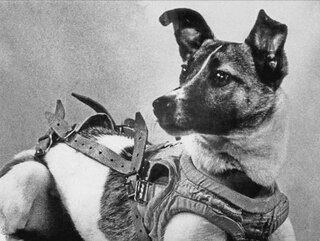
Laika was a Soviet space dog who was one of the first animals in space and the first to orbit the Earth. A stray mongrel from the streets of Moscow, she flew aboard the Sputnik 2 spacecraft, launched into low orbit on 3 November 1957. As the technology to de-orbit had not yet been developed, Laika's survival was never expected. She died of overheating hours into the flight, on the craft's fourth orbit.

Human spaceflight is spaceflight with a crew or passengers aboard a spacecraft, often with the spacecraft being operated directly by the onboard human crew. Spacecraft can also be remotely operated from ground stations on Earth, or autonomously, without any direct human involvement. People trained for spaceflight are called astronauts, cosmonauts (Russian), or taikonauts (Chinese); and non-professionals are referred to as spaceflight participants or spacefarers.

Space exploration is the use of astronomy and space technology to explore outer space. While the exploration of space is currently carried out mainly by astronomers with telescopes, its physical exploration is conducted both by uncrewed robotic space probes and human spaceflight. Space exploration, like its classical form astronomy, is one of the main sources for space science.

A spacecraft is a vehicle that is designed to fly in outer space and operate there. Spacecraft are used for a variety of purposes, including communications, Earth observation, meteorology, navigation, space colonization, planetary exploration, and transportation of humans and cargo. All spacecraft except single-stage-to-orbit vehicles cannot get into space on their own, and require a launch vehicle.
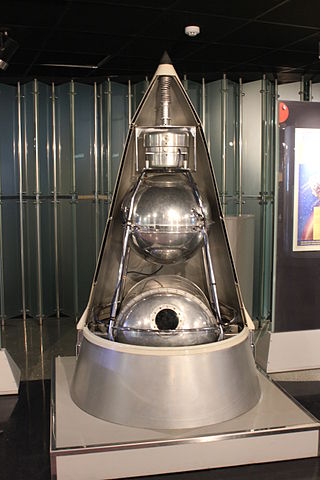
Sputnik 2, or Prosteyshiy Sputnik 2, launched on 3 November 1957, was the second spacecraft launched into Earth orbit, and the first to carry an animal into orbit, a Soviet space dog named Laika.

The Space Race was a 20th-century competition between two Cold War rivals, the United States and the Soviet Union, to achieve superior spaceflight capability. It had its origins in the ballistic missile-based nuclear arms race between the two nations following World War II and had its peak with the more particular Moon Race to land on the Moon between the US moonshot and Soviet moonshot programs. The technological advantage demonstrated by spaceflight achievement was seen as necessary for national security and became part of the symbolism and ideology of the time. The Space Race brought pioneering launches of artificial satellites, robotic space probes to the Moon, Venus, and Mars, and human spaceflight in low Earth orbit and ultimately to the Moon.
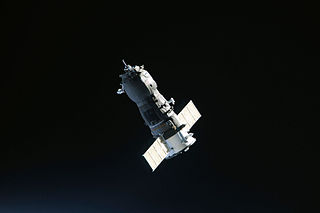
Uncrewed spacecraft or robotic spacecraft are spacecraft without people on board. Uncrewed spacecraft may have varying levels of autonomy from human input; they may be remote controlled, remote guided or autonomous: they have a pre-programmed list of operations, which they will execute unless otherwise instructed. A robotic spacecraft for scientific measurements is often called a space probe or space observatory.
Kosmos is a designation given to many satellites operated by the Soviet Union and subsequently Russia. Kosmos 1, the first spacecraft to be given a Kosmos designation, was launched on 16 March 1962.

Animals in space originally served to test the survivability of spaceflight, before human spaceflights were attempted. Later, many species were flown to investigate various biological processes and the effects microgravity and space flight might have on them. Bioastronautics is an area of bioengineering research that spans the study and support of life in space. To date, seven national space programs have flown animals into space: the United States, Soviet Union, France, Argentina, China, Japan and Iran.

The Vision for Space Exploration (VSE) was a plan for space exploration announced on January 14, 2004 by President George W. Bush. It was conceived as a response to the Space Shuttle Columbia disaster, the state of human spaceflight at NASA, and as a way to regain public enthusiasm for space exploration.
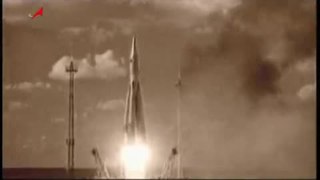
The Soviet space program was the national space program of the Union of Soviet Socialist Republics (USSR), active from 1955 until the dissolution of the Soviet Union in 1991.

During the 1950s and 1960s the Soviet space program used dogs for sub-orbital and orbital space flights to determine whether human spaceflight was feasible. These dogs, including Laika, the first animal to orbit Earth, were surgically modified to provide the necessary information for human survival in space. The Soviet space program typically used female dogs due to their anatomical compatibility with the spacesuit. Similarly, they used mix-breed dogs due to their apparent hardiness.
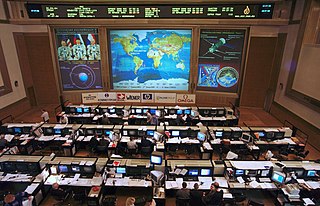
Flight controllers are personnel who aid space flight by working in such Mission Control Centers as NASA's Mission Control Center or ESA's European Space Operations Centre. Flight controllers work at computer consoles and use telemetry to monitor various technical aspects of a space mission in real-time. Each controller is an expert in a specific area and constantly communicates with additional experts in the "back room". The flight director, who leads the flight controllers, monitors the activities of a team of flight controllers, and has overall responsibility for success and safety.
The Lost Cosmonauts or Phantom Cosmonauts are subjects of a conspiracy theory, which alleges that Soviet and Russian space authorities have concealed the deaths of some cosmonauts in outer space. Proponents of the Lost Cosmonauts theory argue that the Soviet Union attempted to launch human spaceflights before Yuri Gagarin's first spaceflight, and that cosmonauts onboard died in those attempts. Soviet military pilot Vladimir Ilyushin was alleged to have landed off course and been held by the Chinese government. The Government of the Soviet Union supposedly suppressed this information, to prevent bad publicity during the height of the Cold War.
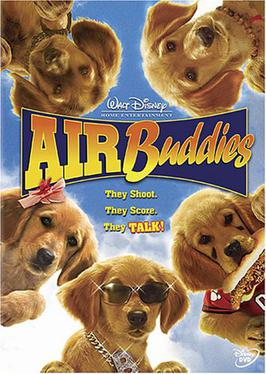
Air Buddies is a 2006 American sports comedy film directed by Robert Vince. It is the sixth film in the Air Bud series and the first in the direct-to-video spin-off series Air Buddies, which follows the life of a lonely teenager and his dog who has the uncanny ability to play every sport.
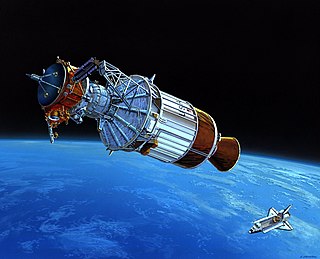
The Inertial Upper Stage (IUS), originally designated the Interim Upper Stage, was a two-stage, solid-fueled space launch system developed by Boeing for the United States Air Force beginning in 1976 for raising payloads from low Earth orbit to higher orbits or interplanetary trajectories following launch aboard a Titan 34D or Titan IV rocket as its upper stage, or from the payload bay of the Space Shuttle as a space tug.
A launch status check, also known as a "go/no go poll" and several other terms, occurs at the beginning of an American spaceflight mission in which flight controllers monitoring various systems are queried for operation and readiness status before a launch can proceed. For Space Shuttle missions, in the firing room at the Launch Control Center, the NASA Test Director (NTD) performed this check via a voice communications link with other NASA personnel. The NTD was the leader of the shuttle test team responsible for directing and integrating all flight crew, orbiter, external tank/solid rocket booster and ground support testing in the shuttle launch countdown. The NTD was also responsible for the safety of all personnel inside the pad after external tank loading, including the flight crew, about 10 go/no go reports. He reported to the Launch Director, who has another about 5 go/no go reports. The Launch director declares if a mission is go for launch.

Spooky Buddies is a 2011 Canadian-American supernatural comedy film that is part of the Disney Buddies franchise, a series often referred to as the Air Bud and Air Buddies franchise. For the fifth installment in the Air Buddies series, the plot follows the team as they have a Halloween adventure in Fernfield to stop the evil Warwick the Warlock and save the town. The film was directed by Robert Vince, produced by Anna McRoberts, and released by Walt Disney Studios Home Entertainment on Blu-ray, DVD, and as a film download on September 20, 2011.

Super Buddies is a 2013 American superhero comedy film. It is the seventh and final installment in the Air Buddies film series, and the fourteenth and final film of the overall Air Bud franchise. It was released on August 27, 2013.
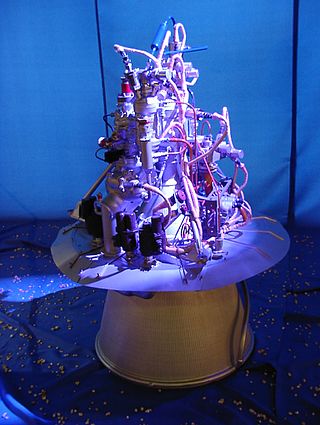
The RD-0109 is a rocket engine burning liquid oxygen and kerosene in a gas generator combustion cycle. It has single nozzle and is an evolution of the RD-0105. It was the engine used on the Vostok Block-E that launched Yuri Gagarin to orbit.

















